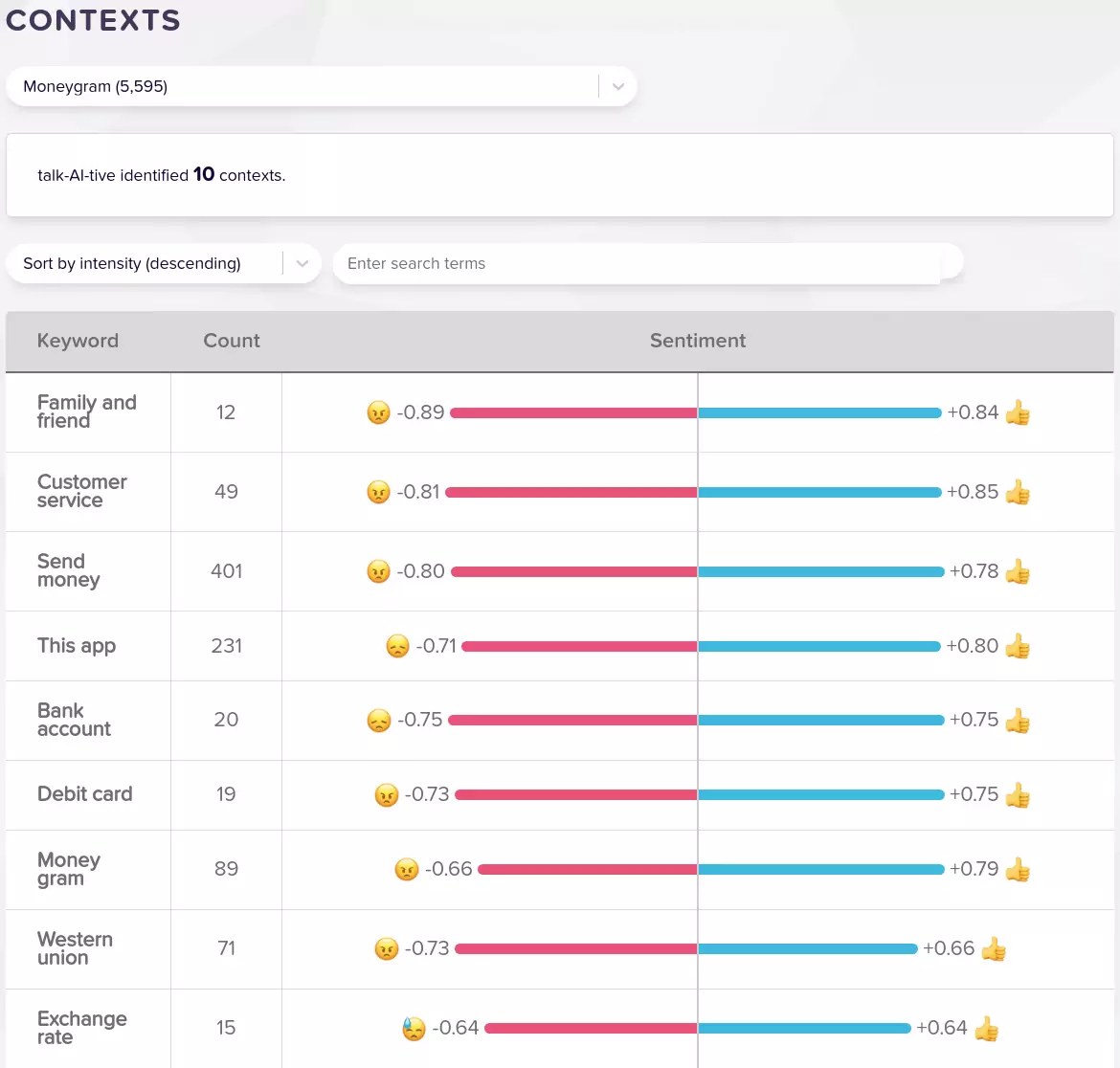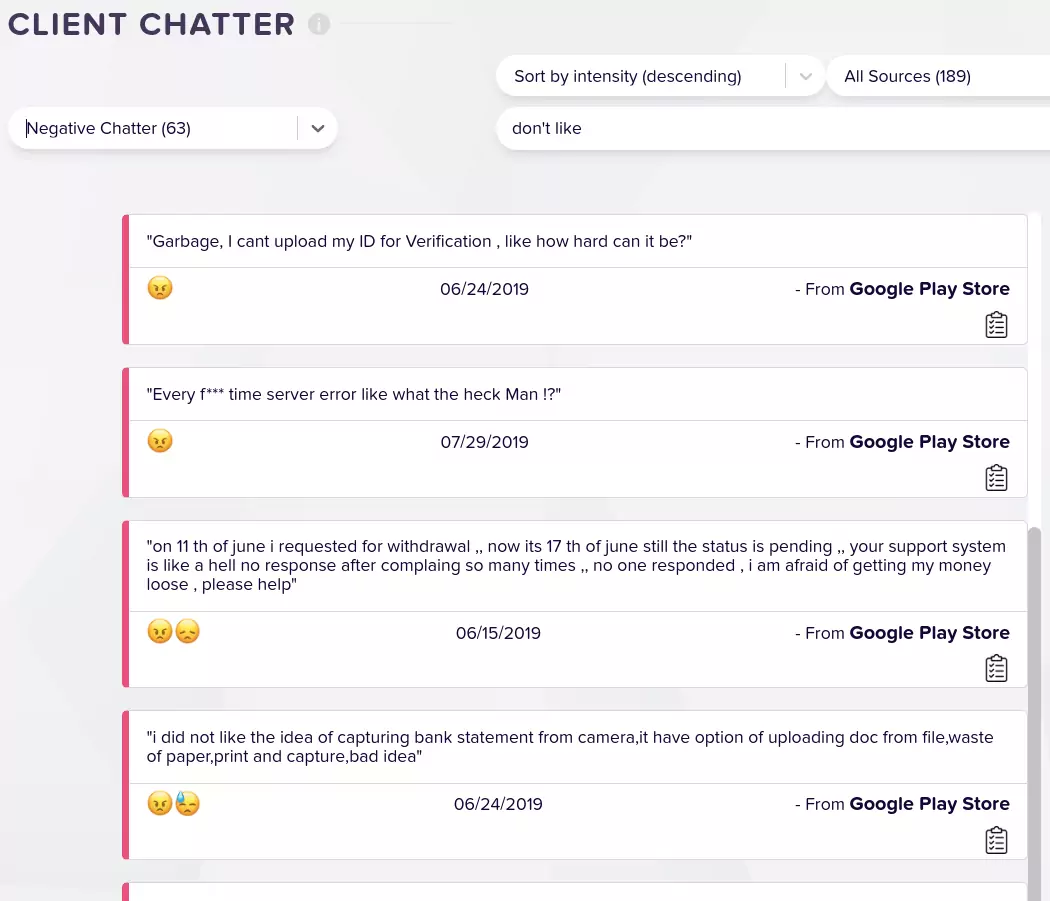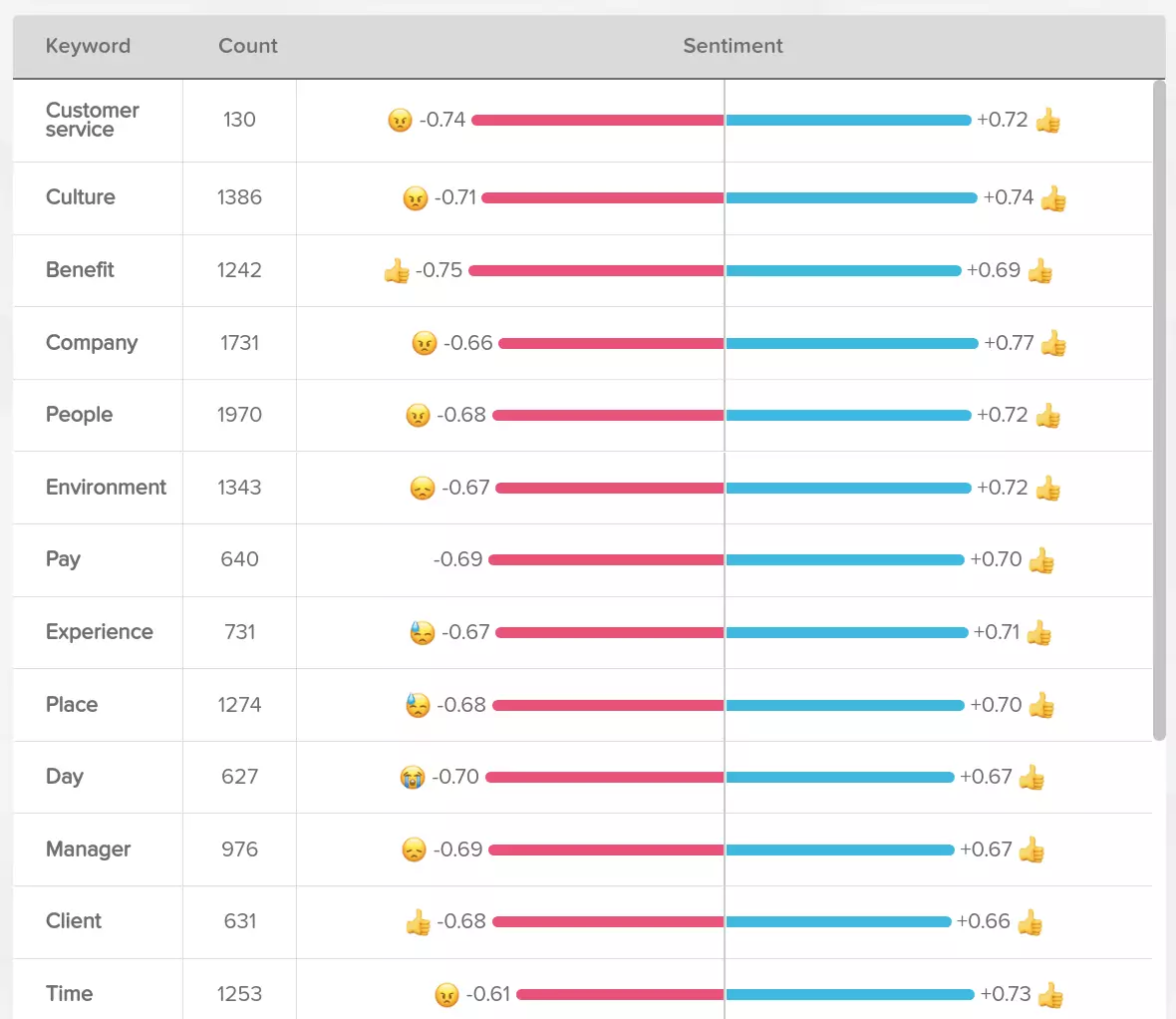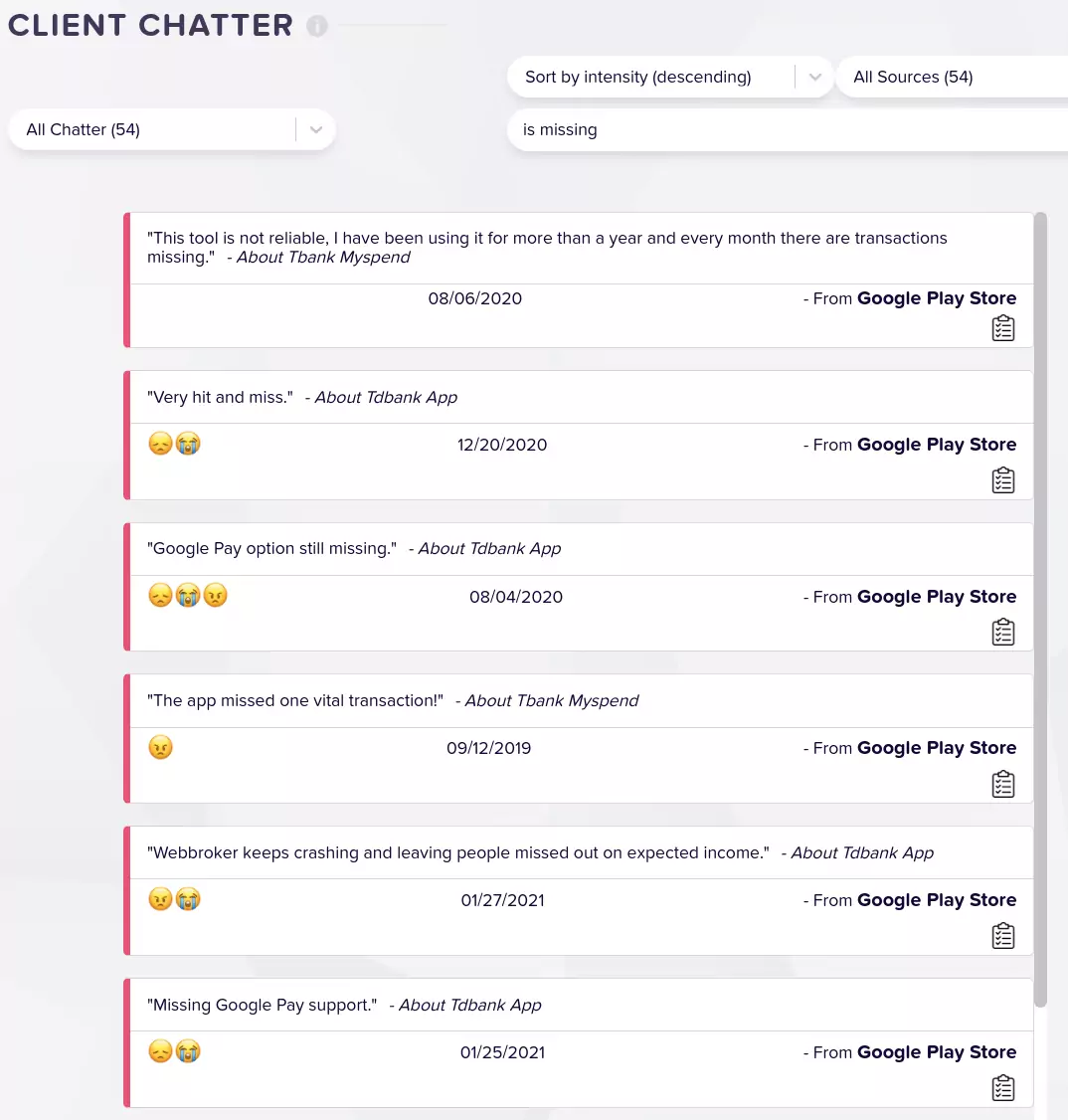Continuing from the previous post, this post will focus on specific aspects of applying talkAItive for marketing research and strategy development and validation. Due to the proprietary nature of the engagements, we will have to obfuscate certain details but the overall application would be similar for any given client.
talkAItive had the opportunity to engage with strategy as a process within the agency, which not only gave us an appreciation for the fast creative work done everyday, but how important the social, customer and product data is to overall validation, refinement and development of key concepts. Their focus to build target profiles and personas based on preferences and real feedback created an opportunity for us to introduce the new range of "Emotional Contexts" and measure sentiment and emotions relative to geo-locations, products and services, channels, and customer lifestyle preferences. This further expanded the range of customer experience analytics gathered at record pace and across a range of social and online platforms.

Focus groups allowed the team to gather details related to very specific topics and talkAItive's sentiment measurement was used to get a read across wider customer chatter clusters. What really helped were emotional contexts chains, which talkAItive identifies to help determine sticky customer issues vs. ones which fizzled out over time. The above illustration is a sample extract which shows the entirety of this output. Each context belongs to a time period which is specified by the client or across the entire time slice. The contexts also show the clustering of negative vs. positive sentiment for a given time period.
To get the pulse of your customer’s emotions, you cannot rely on annual or even quarterly surveys; those are only good to get specific reads on topics you are interested in. However, if your goal is to learn what is important to your customer emotionally, then all this solicited or unsolicited feedback, which talkAItive specializes in processing, is a gold mine for any given brand, personality, or institution.
How Does talkAItive Bring Emotions Into Market Research And Marketing Strategy?
Typically market research focuses on understanding customer preferences in relation to products, services, brand, and other key assets.
Emotion enhanced market research involves gathering insights across all sources of customer feedback - social, web, NPS, email, bots, call center, and more. Frequency or count based insights are extremely valuable (likes, hearts, other aggregates) to get a gauge of your engagement, but does engagement detail emotion? What does your gut tell you?
What makes talkAItive different is the focus on learning the nuances of emotions across products and services vs. the count and frequency based metrics which give you a number. talkAItive supported market research is:
- Cost Effective: Each refresh across all chatter sources is a lot cheaper than a fully planned research panel. You can run this many times and build a continuous chain of emotional metrics which combine well with your existing survey results.
- Flash Fast: Well, relatively! While normal market research methods can take 15-30 days or more, talkAItive can get you measurement of sentiment AND emotion from 5,000 data points every 10 minutes. How is that for keeping a finger on the pulse?
- Comprehensive: 4.48 billion people currently use social media worldwide, up more than double from 2.07 billion in 2015 (source: statista). There is no lack of chatter, perspectives, opinions, accolades online, and in your own internal customer chatter data. A platform like talkAItive makes it easy to gather and learn from all that data, together, to help you find emotions and their trends across your products, services, and brands.
Powered with talkAItive’s capability to process customer reviews, comments, social media chatter, call center transcripts, bot data, and more, you can expect to get rich details to typical questions which are addressed as part of any given market research or market strategy development effort. Some of those aspects are described below.
In the following sections you will see examples related to a financial services app, where the client had the following objectives related to market research and strategy:
- Build emotional baselines relative to "Accounts", "Security", "Experience", and "Features" categories.
- Compare the contrast and similarities in emotional contexts versus the competitors and industries.
- Use social data against their apps on popular app stores.
Below are some key questions which talkAItive analysis help answer in relation to all your customer chatter, like customer service, product use, sales experience, onboarding, or anything that might be related to your brand, product or influencers.
What Do They Love About You?
In our experience, which is contrary to the general belief that only negative or positive chatter is prevalent online, we found a varying distribution of chatter across both positive and negative sentiment. There is no single reason why users leave a review, however, that reason has a tremendous amount of emotional intensity which makes it such a wonderful resource for learning.
Customers routinely leave short and long forms of positive accolades, which is excellent for identifying those precious emotional contexts to be used later for boosting that same emotion. This is achieved through including or building your content around positive customer experience scenarios which talkAItive helps you learn, identify, and rank!

Companion image shows key emotional contexts related to an app developer.
talkAItive found multiple contexts related to specific product features and customer experience touchpoints like delivery and customer service.
They talked about why the service, product, or onboarding experience was so great and something they wished other brands followed. The other side of this are the emotional contexts related to your competitor’s brand, product, or service, those are opportunities to differentiate or show your mettle in that same category.
How Do They Like To Use Your Products Or Services?

Search a database for Voice Of Customer by topics and phrases.
Another aspect of marketing research is to learn how the products or services are typically used and have a positive impact.
Here you find an abundance of ideas to apply to your content and campaign strategy.
They already love the taste of your product, amplifying this emotional context as social proof keeps your content and campaign fresh and relatable.
In the companion illustration, you will see how our app developer client used specific terms to find related emotional chatter across sources and time. In this case it is related to everytime customers mention the "use it" phrase.
Tell the world how your customers love to use your product - it’s what they said!
What Do They Dislike About You?
Negative Reviews and Feedback - This is the category that typically garners the most interest across our clients. Emotional contexts related to scenarios where the brand or product is disappointing is a critical component for enabling continuous improvement into your brand, marketing and product development.
In this example, the user is interested in learning the top contexts related to what customers "don’t like" and ranked by sentiment intensity.

How Does Your Emotional Response Compare To Your Competitors Or Industry?
Another valuable resource that talkAItive unlocks is the ability to compare your emotional response to that of your competitor or industry. In our example the App chatter is compared to the Industry chatter based on other competitor apps.
The clients were able to identify a variety of emotional contexts which were in alignment or in contrast to the compared baseline or competitor.

What Does The Employee Experience Tell You?
Happy employees translates to happy customers and adding employee experience as a key input to your marketing strategy development will tell you exactly what your employees think and likely express whenever they engage with your customers.
If becoming a customer centric organization is part of your plans, there is a lot of good research that suggests that employee experience is where you want to start. This is also explained well in thisarticle from Forbes which relates this connection. A variety of web and customer anonymised data is a rich resource to learn things like:
- Which tools and information points are missing to improve customer experience?
- What is the culture like - are they valued, respected, and listened to?
- Do they see worthwhile personal and professional development opportunities?

In our engagement, we mapped this across chatter found on Indeed and Glassdoor.
Incidentally, a lot of chatter was from the customer service department and flashed a light on what was lacking across the three themes listed above.
What Do They Wish You Had?
I wish they _________________________.

Ability to learn what your customers feel that is missing needs to be a top priority.
A simple search of "is missing" or "wish it has" and others, find what your customer aspires for relative to your product or service.
It does not get any more direct than this when it comes to customer feedback. Compared to frequency based metrics, the emotion metrics help ground your decisions with the real "voice of customer", based on emotional and sentiment intensity.
Unlock A New Resource To Super-Charge Your Marketing Research and Strategy
The best marketing campaigns are the ones which are able to evoke specific emotions from its audience. This worthy goal, however, requires a seamless way to continuously learn and track specific emotions across your customer chatter. Imagine your brand is able to not just learn, but also engage using specific emotional goals and profiles, which ultimately lead to a deeper customer understanding and engagement.
Emotions are personal, so much more than a number or metric. Emotions are nuanced, they flow freely over time and thanks to social media, they can be expressed as freely as never before.
Our goal is to help you identify, track and evoke these emotions through your customer engagements. If this is something you are ready or curious about - contact us here.

